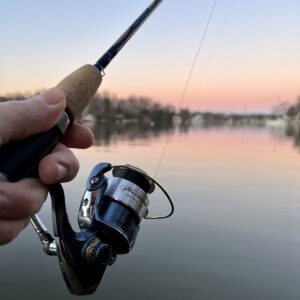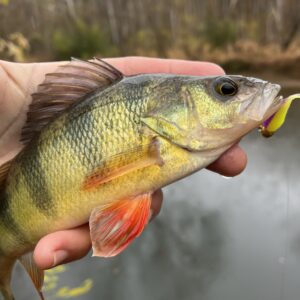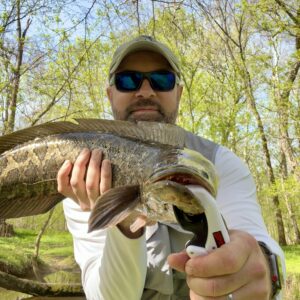Welcome to Reel Chesapeake’s Weekly Fishing Report, our interpretation of what’s biting and where throughout the Chesapeake Bay watershed. Please email us directly at editor@reelchesapeake.com to share updates and photographs of your recent catches for potential inclusion in next week’s column. The leading photograph (above): Many of the tidal/brackish salt ponds of the region will hold white perch during spring. This is one of several caught at one such pond during a Saturday spent in southern Anne Arundel County.
Welcome to the first spring report, seeing as the equinox came this past Tuesday into Wednesday. With it…a front that dropped temperatures to freezing and whipped up near-gale force winds. Go figure. After a gorgeous, mostly sunny weekend, the past several days have been very gusty and cold, which has made the bite difficult for several species. This classic March weather will continue its fluctuations into the weekend and the week ahead with sunny days and wet ones, windy and…well, windy, it seems. Temps will inch up and hold in the mid-50Fs though, so that should keep multiple fisheries moving along, as they run to spawn.
In the open water of the middle Chesapeake the charter fleet continues to angle for trophy stripers ahead of the fishery’s April 1st closure. There’s a week and change left to catch the fish of a lifetime as cow stripers continue to push up the bay and into the spawning rivers (which are currently off-limits to striper fishing). You can fish for these stripers in the bay’s main stem and captains reported a tougher bite this week, mostly due to difficulty holding position in the winds, which made lure presentation and maintaining the strike zone a challenge. The preferred lure has been 1.5- to 2-ounce jigheads with large 7- to 10-inch plastics. Nonetheless, the word—from the likes of Capt. Jamie Clough, among others—was that fish were holding to bait balls in deep water along channel edges and transition points. You’d be lucky to find five fish on a ball of bait—more likely to find just one or two. But those fish have been large and healthy, up to 50-inchers—thus, worth the time and effort to locate them in open water. Popular locations include open water ahead of the mouths of major rivers such as the Potomac, Patuxent, Patapsco, and Choptank.
White perch have been very active as they continue pushing into spawning tributaries. On the heels of a couple good reports, I ventured to the salt ponds on the south side of the South River and enjoyed an excellent day of perch jerkin’ with fish up to 11-inches. They hit a variety of lures including a tandem rig with a small hair jig and a nungesser spoon, as well as a 1/16-ounce stumpjumper. A little silver flash dancing in the water seemed to get the strikes. Other reports came in from the upper Patuxent, upper Tuckahoe, and what’s become one of the more favored spots on the Eastern Shore, Red Bridges at Greensboro (note, when fishing above the Rt. 313 bridge, DNR regs state you need a non-tidal license—even though that’s still tidal-influenced water.)
Shad runs are also getting a lot of attention from shore bound anglers and those willing to kayak sometimes sketchy waters (watch the wind forecasts). The report from Fletcher’s Cove on the Potomac is that the run of hickory shad is starting quite nicely with daily catches reported. The boathouse opens this weekend at Fletcher’s, signaling the official start of shad season. There, you’ll be able to talk shop with staff who’ll outfit you with the preferred lures of the week. Best to bring a mixed bag of darts and spoons in various weights and colors, as the shad could be holding shallow or deep and will hit “who knows what color” at any given time. Testing various lures, retrieves, etc. should eventually put you on fish, which are usually at the line between current and slack water.

This morning (Thursday), I also made my way to a particular Prince George’s County spot along the Patuxent to test those waters. Target was white perch, of which I found none (last night’s 32F temp likely cooled any chance of a bite), but I did hook into a very nice sized hickory shad with a 1/16-ounce stump jumper tipped with a silver stinger. The frisky fella shook off the hook just before netting, so no picture. Darn. It’s still early by my estimation for hickory, or Americans, in this stretch of water, so I was not surprised to not find any more of them despite my repeated casts along a 1/4-mile stretch of water.
Blue catfish are becoming a target du jour, especially with the impending striper moratorium through May 15th. Mixed reports all over the region, but mostly good. Both bank fishermen and boaters have been landing fish in the 10- to 15-pound range, plus a few hogs upwards of 30. Various bottom rigs and the freshest chunk bait are preferred—use 2- to 3-ounces of lead to hold the bottom. The lower, deeper sections of most tributaries are best to target, especially so in the Choptank, Patuxent, and Potomac.
Freshwater (and brackish) species including largemouth bass, crappie, bluegill, and northern snakehead will hopefully start biting with more frequency in the week(s) ahead. But the past several days yielded fewer reports than the week before—likely due to the very cold weather that blasted us. Jerkbaits or small square-bill cranks are a good pick if you aim for the largemouth this week; chatter-style or inline spinner lures for snakehead; and weedless paddletails worked slowly for both. Crappie and bluegill should be hugging laydowns that reach into 5-plus feet of water. Stingers, micropaddles, beetlespins, and even tiny rat-l-traps can get bites. The small lakes, millponds, and reservoirs that dot the region are go-tos. We saw the water was back up at Triadelphia, which bodes well for anglers in the Central Maryland region.
Chain pickerel will continue hitting lures with abandon, so long as you can find them. They’ll be holding at the docks/piers/cover closest to transitions between deep water and shallow. Remember, it’s illegal to harvest tidal chain pickerel right now—catch and release is fine. Best tribs to try for them: Magothy, Severn, South, Tuckahoe, and way upper Choptank.
Common carp are also on the radar of diehards who love the fighting spirit of these large fish. They’ll start spawning as May nears, but are feeding hard now. Catching them on the fly is becoming a challenge more and more anglers are willing to try. Sinking fly or worm presentations may be best at the moment until trees and shrubs begin flowering at which point, mulberry-like flies on top might be worth a try. Another option is old-fashioned bottom fishing with doughballs or canned corn. You’ll want to “feed” the area you’re fishing to attract the fish. Waters to try include the Patapsco west of Baltimore, western branch of the Patuxent, and the headwaters of Severn, Bush, Middle, and Gunpowder. Carp fishing can become an addicting sport as you discover techniques, recipes, and nuances of attracting the species. Good luck!
This report appears within On The Water magazine’s weekly collection of Chesapeake Bay fishing reports.





